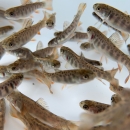American shad is the largest herring found in North America, growing up to two feet long and up to six pounds in weight. American shad can be found along the Atlantic coast, from Florida all the way up to Canada. Like the Atlantic salmon, American shad are also anadromous. In May, adults are collected at the Essex Dam in Lawrence, MA, and are brought back to the facility to spawn. American shad spawn at night, with each female releasing upwards of 300,000 eggs! About 10 days after the eggs hatch, we release the young fry into the Merrimack River. The released American shad fry will mature to adulthood and return to the Merrimack River to spawn their own offspring.
American shad eggs are obtained from adult shad returning to the Merrimack River. The eggs are incubated at the hatchery, and once they hatch, the juveniles are released into sections of the Merrimack River and other New England rivers.



